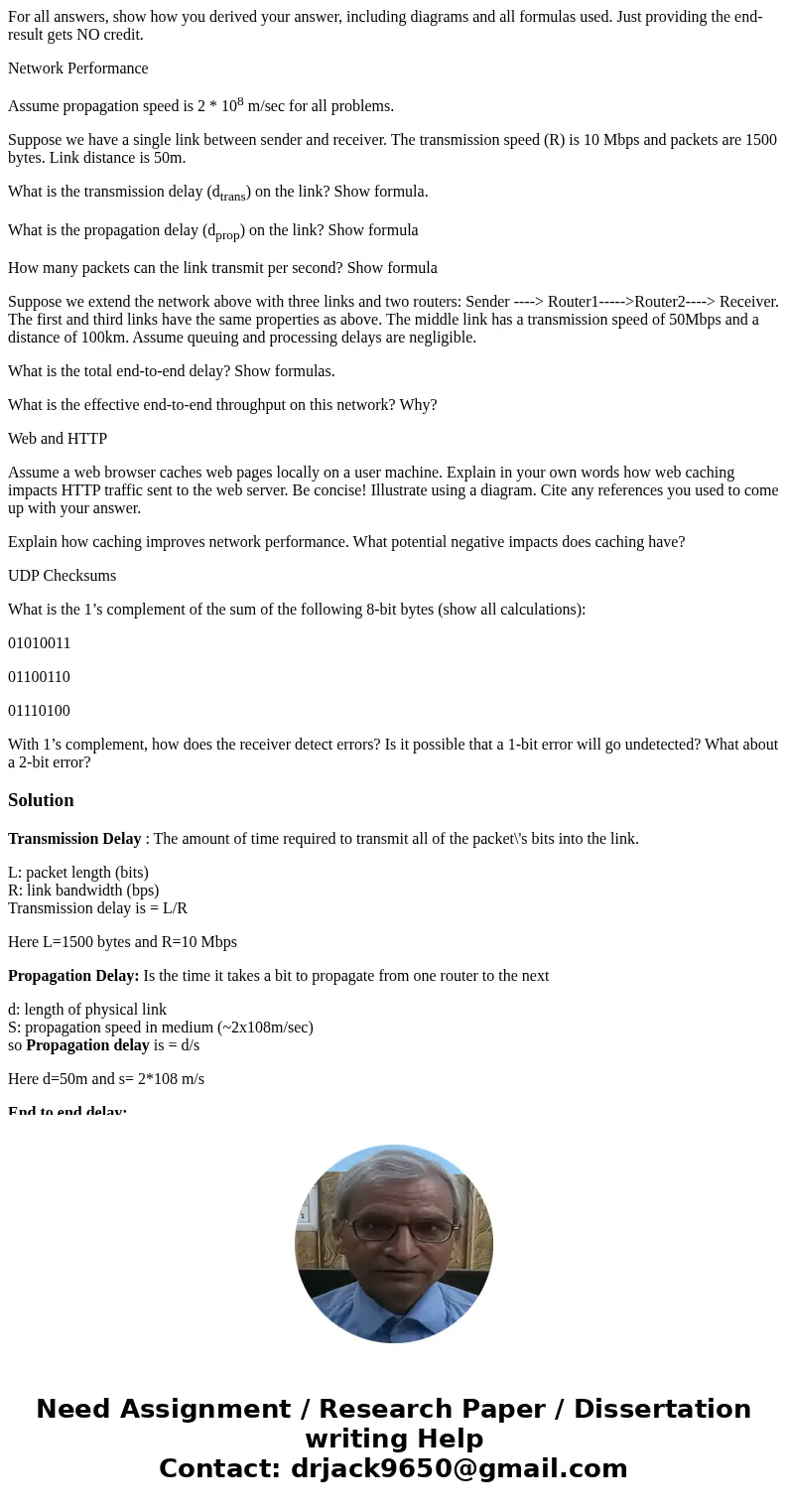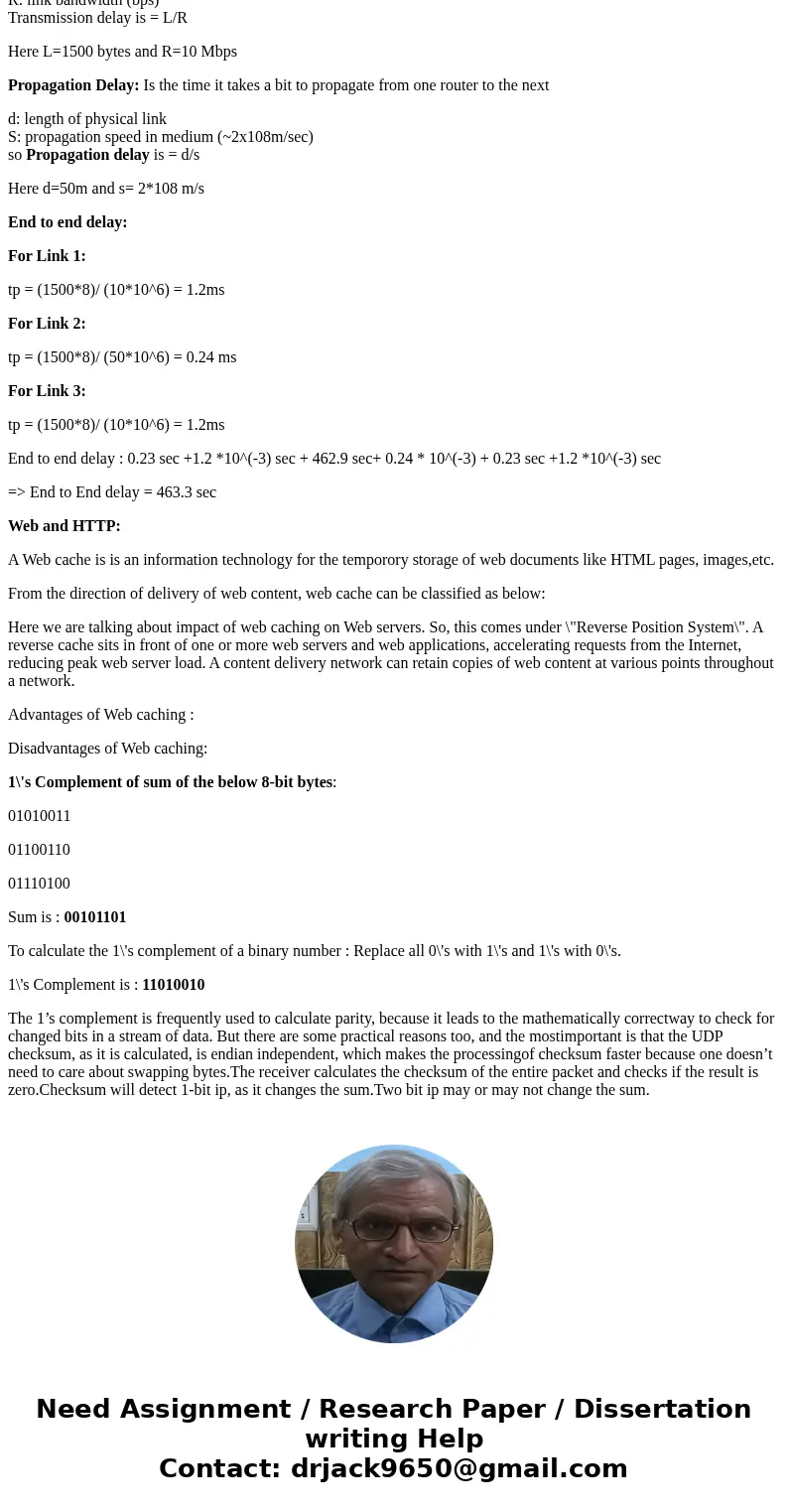For all answers show how you derived your answer including d
For all answers, show how you derived your answer, including diagrams and all formulas used. Just providing the end-result gets NO credit.
Network Performance
Assume propagation speed is 2 * 108 m/sec for all problems.
Suppose we have a single link between sender and receiver. The transmission speed (R) is 10 Mbps and packets are 1500 bytes. Link distance is 50m.
What is the transmission delay (dtrans) on the link? Show formula.
What is the propagation delay (dprop) on the link? Show formula
How many packets can the link transmit per second? Show formula
Suppose we extend the network above with three links and two routers: Sender ----> Router1----->Router2----> Receiver. The first and third links have the same properties as above. The middle link has a transmission speed of 50Mbps and a distance of 100km. Assume queuing and processing delays are negligible.
What is the total end-to-end delay? Show formulas.
What is the effective end-to-end throughput on this network? Why?
Web and HTTP
Assume a web browser caches web pages locally on a user machine. Explain in your own words how web caching impacts HTTP traffic sent to the web server. Be concise! Illustrate using a diagram. Cite any references you used to come up with your answer.
Explain how caching improves network performance. What potential negative impacts does caching have?
UDP Checksums
What is the 1’s complement of the sum of the following 8-bit bytes (show all calculations):
01010011
01100110
01110100
With 1’s complement, how does the receiver detect errors? Is it possible that a 1-bit error will go undetected? What about a 2-bit error?
Solution
Transmission Delay : The amount of time required to transmit all of the packet\'s bits into the link.
L: packet length (bits)
R: link bandwidth (bps)
Transmission delay is = L/R
Here L=1500 bytes and R=10 Mbps
Propagation Delay: Is the time it takes a bit to propagate from one router to the next
d: length of physical link
S: propagation speed in medium (~2x108m/sec)
so Propagation delay is = d/s
Here d=50m and s= 2*108 m/s
End to end delay:
For Link 1:
tp = (1500*8)/ (10*10^6) = 1.2ms
For Link 2:
tp = (1500*8)/ (50*10^6) = 0.24 ms
For Link 3:
tp = (1500*8)/ (10*10^6) = 1.2ms
End to end delay : 0.23 sec +1.2 *10^(-3) sec + 462.9 sec+ 0.24 * 10^(-3) + 0.23 sec +1.2 *10^(-3) sec
=> End to End delay = 463.3 sec
Web and HTTP:
A Web cache is is an information technology for the temporory storage of web documents like HTML pages, images,etc.
From the direction of delivery of web content, web cache can be classified as below:
Here we are talking about impact of web caching on Web servers. So, this comes under \"Reverse Position System\". A reverse cache sits in front of one or more web servers and web applications, accelerating requests from the Internet, reducing peak web server load. A content delivery network can retain copies of web content at various points throughout a network.
Advantages of Web caching :
Disadvantages of Web caching:
1\'s Complement of sum of the below 8-bit bytes:
01010011
01100110
01110100
Sum is : 00101101
To calculate the 1\'s complement of a binary number : Replace all 0\'s with 1\'s and 1\'s with 0\'s.
1\'s Complement is : 11010010
The 1’s complement is frequently used to calculate parity, because it leads to the mathematically correctway to check for changed bits in a stream of data. But there are some practical reasons too, and the mostimportant is that the UDP checksum, as it is calculated, is endian independent, which makes the processingof checksum faster because one doesn’t need to care about swapping bytes.The receiver calculates the checksum of the entire packet and checks if the result is zero.Checksum will detect 1-bit ip, as it changes the sum.Two bit ip may or may not change the sum.


 Homework Sourse
Homework Sourse